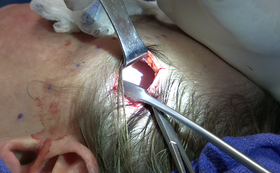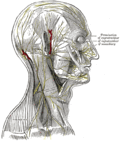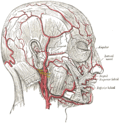Rhytidectomy
| Rhytidectomy | |
|---|---|
| Intervention | |

Temporal incision behind the hairline in endoscopic midface lift (rhytidectomy). Note the shiny surface of the deep temporal fascia. This plane is dissected down to the orbital rim and connected to the midface subperiosteal plane created through the sublabial incision under the upper lip, and often through a lower eyelid incision.
|
|
| ICD-9-CM | 86.82 |
| MedlinePlus | 002989 |
| Facelift: Generally relevant anatomy | |
|---|---|

Head nerves
|
|

Head arteries
|
|
| Details | |
| Artery | Facial artery, Temporal artery, Arteria supratrochlearis, Arteria infraorbitalis |
| Vein | Temporal vein |
| Nerve | Greater auricular nerve, Facial nerve, Mental nerve |
| Identifiers | |
| MeSH | E04.680.655 |
|
Anatomical terminology
[]
|
|
A facelift, technically known as a rhytidectomy (from Ancient Greek ῥυτίς (rhytis) "wrinkle" + ἐκτομή (ektome) "excision", surgical removal of wrinkles), is a type of cosmetic surgery or facial toning procedure used to give a more youthful facial appearance. There are multiple surgical techniques and exercise routines. Surgery usually involves the removal of excess facial skin, with or without the tightening of underlying tissues, and the redraping of the skin on the patient's face and neck. Exercise routines tone underlying facial muscles without surgery. Surgical facelifts are effectively combined with eyelid surgery (blepharoplasty) and other facial procedures and are typically performed under general anesthesia or deep twilight sleep.
According to the most recent 2011 statistics from the American Society for Aesthetic Plastic Surgery, facelifts were the sixth most popular aesthetic surgery performed after liposuction, breast augmentation, abdominoplasty (tummy tuck), blepharoplasty (eyelid surgery) and breast lift.
In the first 70 years of the 20th century facelifts were performed by pulling on the skin on the face and cutting the loose parts off. The first facelift was reportedly performed by Eugen Holländer in 1901 in Berlin. An elderly Polish female aristocrat asked him to: "lift her cheeks and corners of the mouth". After much debate he finally proceeded to excise an elliptical piece of skin around the ears. The first textbook about facial cosmetic surgery (1907) was written by Charles Miller (Chicago) entitled "The Correction of Featural Imperfections".
In the First World War (1914–1918) the Dutch surgeon Johannes Esser made one of the most famous discoveries in the field of plastic surgery to date, namely the "skin graft inlay technique," the technique was soon used on both English and German sides in the war. At the same time the British plastic surgeon Harold Delfs Gillies used the Esser-graft to school all those who flocked towards him who wanted to study under him. That’s how he earned the name "Father of 20th Century Plastic Surgery". In 1919 Dr. Passot was known to publish one of the first papers on face-lifting, this consisted mainly on the elevating and redraping of the facial skin. After this many others began to write papers on face-lifting in the 1920s. From then the esthetic surgery was being performed on a large scale, from the basis of the reconstructive surgery. The first female plastic surgeon, Suzanne Noël, played a large role in its development and she wrote one of the first books about esthetic surgery named: "Chirurgie Esthetique, son rôle social."
...
Wikipedia
